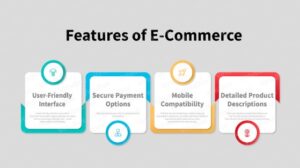Introduction
In today’s digital age, ecommerce has revolutionized the way businesses operate. Whether you’re a startup or an established brand, having an online store is essential for success. Ecommerce website development services help businesses create user-friendly, secure, and high-performing online stores that drive sales and enhance customer experience. This article explores the importance of ecommerce website development, key features, development process, and how to choose the right service provider.
Importance of Ecommerce Website Development

1. Expanding Business Reach
Ecommerce websites enable businesses to reach a global audience. Unlike physical stores, online stores are accessible 24/7, allowing customers to shop anytime, anywhere.
2. Increased Sales and Revenue
With effective ecommerce website development, businesses can boost sales through features like personalized product recommendations, seamless checkout processes, and multiple payment options.
3. Cost-Effective Operations
Running an online store reduces overhead costs associated with rent, utilities, and in-store staffing. It also allows businesses to automate various processes like inventory management and order processing.
4. Enhanced Customer Experience
A well-designed ecommerce website offers a smooth shopping experience with features like easy navigation, mobile responsiveness, fast loading speed, and secure transactions.
Key Features of a High-Performing Ecommerce Website

1. User-Friendly Interface
A simple, intuitive design ensures that customers can easily browse products, add them to the cart, and complete their purchase without confusion.
2. Mobile Responsiveness
With the majority of online shopping happening on mobile devices, a responsive design ensures a seamless shopping experience across smartphones, tablets, and desktops.
3. Secure Payment Gateway
Integrating secure payment methods like PayPal, Stripe, or credit card processing ensures safe transactions and builds customer trust.
4. Fast Loading Speed
Slow websites drive customers away. Optimizing images, using content delivery networks (CDNs), and implementing efficient coding practices can improve site speed.
5. SEO Optimization
A well-optimized ecommerce website ranks higher on search engines, driving organic traffic and increasing visibility.
6. Advanced Search and Filters
Customers should be able to easily find products using search bars, filters, and sorting options.
7. Customer Reviews and Ratings
Displaying customer reviews builds credibility and influences purchasing decisions.
8. Multiple Payment and Shipping Options
Providing various payment and shipping methods caters to diverse customer preferences, increasing conversion rates.
9. Inventory Management System
An integrated inventory system helps businesses track stock levels, manage orders, and prevent overselling or stockouts.
10. Analytics and Reporting
Tracking customer behavior, sales performance, and other key metrics helps in making data-driven decisions for business growth.
Also Read: Immersive Retail Experiences: How AR and VR are changing shopping in 2024
Ecommerce Website Development Process
Step 1: Planning and Research
The development process begins with understanding business goals, target audience, and competitor analysis to create a tailored strategy.
Step 2: Choosing the Right Platform
Selecting an ecommerce platform like Shopify, WooCommerce, Magento, or BigCommerce depends on budget, scalability, and required features.
Step 3: Website Design
The website’s design should be visually appealing, mobile-friendly, and aligned with the brand’s identity.
Step 4: Development and Integration
Developers build the website using programming languages and integrate essential features such as payment gateways, shipping options, and CRM systems.
Step 5: Testing and Quality Assurance
Before launch, the website undergoes rigorous testing for functionality, security, and performance to ensure a seamless user experience.
Step 6: Deployment and Launch
After successful testing, the website is deployed on a live server, making it accessible to customers.
Step 7: Maintenance and Support
Regular updates, security patches, and performance optimizations are essential for keeping the ecommerce website running smoothly.
How to Choose the Right Ecommerce Website Development Service
1. Experience and Expertise
Look for a development service provider with a proven track record and experience in creating ecommerce websites.
2. Portfolio and Client Reviews
Check their portfolio and client testimonials to assess the quality of their work and customer satisfaction.
3. Customization and Scalability
Ensure that the service provider offers customizable solutions and scalable features to accommodate future business growth.
4. Technical Support and Maintenance
A reliable provider should offer ongoing support, updates, and troubleshooting assistance.
5. Cost and Budget
Compare pricing models and choose a service that offers the best value without compromising quality.
Conclusion
Ecommerce website development is a crucial investment for any business looking to succeed in the digital marketplace. A well-developed ecommerce site enhances customer experience, increases sales, and streamlines operations. By choosing the right development service, businesses can create a powerful online store that drives long-term success. Whether you are starting fresh or upgrading an existing store, partnering with a professional ecommerce development company can help you achieve your business goals effectively.

